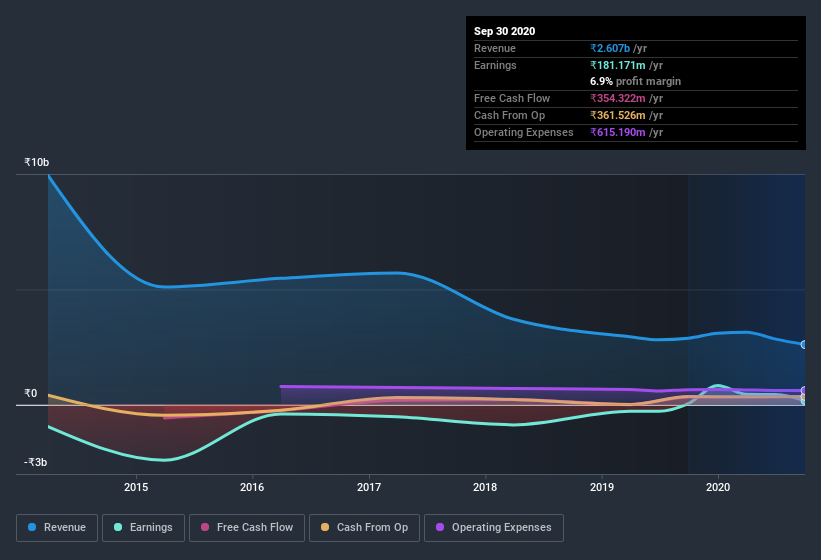- India
- /
- Electrical
- /
- NSEI:KECL
Does Kirloskar Electric's (NSE:KECL) Statutory Profit Adequately Reflect Its Underlying Profit?
Many investors consider it preferable to invest in profitable companies over unprofitable ones, because profitability suggests a business is sustainable. Having said that, sometimes statutory profit levels are not a good guide to ongoing profitability, because some short term one-off factor has impacted profit levels. Today we'll focus on whether this year's statutory profits are a good guide to understanding Kirloskar Electric (NSE:KECL).
While Kirloskar Electric was able to generate revenue of ₹2.61b in the last twelve months, we think its profit result of ₹181.2m was more important. The chart below shows that while revenue has fallen over the last three years, the company has moved from unprofitable to profitable.
View our latest analysis for Kirloskar Electric

Not all profits are equal, and we can learn more about the nature of a company's past profitability by diving deeper into the financial statements. So today we'll look at what Kirloskar Electric's cashflow and unusual items tell us about the quality of its earnings. Note: we always recommend investors check balance sheet strength. Click here to be taken to our balance sheet analysis of Kirloskar Electric.
Zooming In On Kirloskar Electric's Earnings
As finance nerds would already know, the accrual ratio from cashflow is a key measure for assessing how well a company's free cash flow (FCF) matches its profit. In plain english, this ratio subtracts FCF from net profit, and divides that number by the company's average operating assets over that period. This ratio tells us how much of a company's profit is not backed by free cashflow.
As a result, a negative accrual ratio is a positive for the company, and a positive accrual ratio is a negative. That is not intended to imply we should worry about a positive accrual ratio, but it's worth noting where the accrual ratio is rather high. To quote a 2014 paper by Lewellen and Resutek, "firms with higher accruals tend to be less profitable in the future".
Over the twelve months to September 2020, Kirloskar Electric recorded an accrual ratio of -0.27. That indicates that its free cash flow quite significantly exceeded its statutory profit. To wit, it produced free cash flow of ₹354m during the period, dwarfing its reported profit of ₹181.2m. Kirloskar Electric's free cash flow improved over the last year, which is generally good to see. Having said that, there is more to the story. We can see that unusual items have impacted its statutory profit, and therefore the accrual ratio.
The Impact Of Unusual Items On Profit
While the accrual ratio might bode well, we also note that Kirloskar Electric's profit was boosted by unusual items worth ₹761m in the last twelve months. While it's always nice to have higher profit, a large contribution from unusual items sometimes dampens our enthusiasm. When we analysed the vast majority of listed companies worldwide, we found that significant unusual items are often not repeated. And, after all, that's exactly what the accounting terminology implies. We can see that Kirloskar Electric's positive unusual items were quite significant relative to its profit in the year to September 2020. As a result, we can surmise that the unusual items are making its statutory profit significantly stronger than it would otherwise be.
Our Take On Kirloskar Electric's Profit Performance
In conclusion, Kirloskar Electric's accrual ratio suggests its statutory earnings are of good quality, but on the other hand the profits were boosted by unusual items. Given the contrasting considerations, we don't have a strong view as to whether Kirloskar Electric's profits are an apt reflection of its underlying potential for profit. In light of this, if you'd like to do more analysis on the company, it's vital to be informed of the risks involved. Be aware that Kirloskar Electric is showing 4 warning signs in our investment analysis and 1 of those shouldn't be ignored...
Our examination of Kirloskar Electric has focussed on certain factors that can make its earnings look better than they are. But there are plenty of other ways to inform your opinion of a company. For example, many people consider a high return on equity as an indication of favorable business economics, while others like to 'follow the money' and search out stocks that insiders are buying. So you may wish to see this free collection of companies boasting high return on equity, or this list of stocks that insiders are buying.
If you’re looking to trade Kirloskar Electric, open an account with the lowest-cost* platform trusted by professionals, Interactive Brokers. Their clients from over 200 countries and territories trade stocks, options, futures, forex, bonds and funds worldwide from a single integrated account. Promoted
Valuation is complex, but we're here to simplify it.
Discover if Kirloskar Electric might be undervalued or overvalued with our detailed analysis, featuring fair value estimates, potential risks, dividends, insider trades, and its financial condition.
Access Free AnalysisThis article by Simply Wall St is general in nature. It does not constitute a recommendation to buy or sell any stock, and does not take account of your objectives, or your financial situation. We aim to bring you long-term focused analysis driven by fundamental data. Note that our analysis may not factor in the latest price-sensitive company announcements or qualitative material. Simply Wall St has no position in any stocks mentioned.
*Interactive Brokers Rated Lowest Cost Broker by StockBrokers.com Annual Online Review 2020
Have feedback on this article? Concerned about the content? Get in touch with us directly. Alternatively, email editorial-team@simplywallst.com.
About NSEI:KECL
Kirloskar Electric
Engages in the manufacturing and sale of various electrical equipment in India and internationally.
Slight risk with mediocre balance sheet.
Similar Companies
Market Insights
Community Narratives





